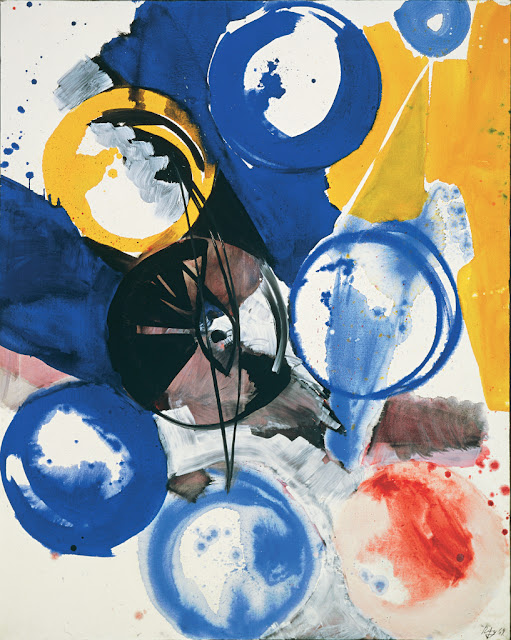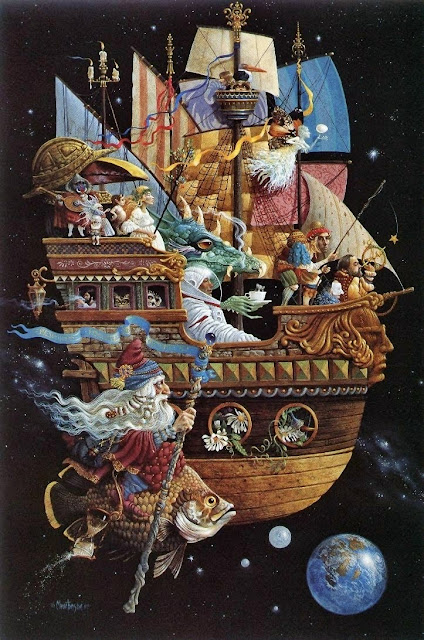LeRoy Neiman (born LeRoy Leslie Runquist, June 8, 1921 – June 20, 2012) was an American artist known for his brilliantly colored, expressionist paintings and screen prints of athletes, musicians, and sporting events.Neiman was born in 1921 in Saint Paul, Minnesota, the son of Lydia Sophia (née Serline) of Braham, Minnesota[1] and Charles Julius Runquist, who were married in 1918, and living at Grasston, Minnesota (Kanabec County). He was of Turkish and Swedish descent ("as near as I can figure out," as he has said) His father deserted his family, and when his mother married his stepfather, John L. Niman (Neiman) in 1926, LeRoy changed to the new surname as well. His mother divorced Neiman about 1935, and married for the third time in about 1940, to Ernst G. Hoelscher, of St. Paul. She died in St. Paul on November 14, 1985 at age 87. LeRoy was raised in the Macalester-Groveland and Frogtown neighborhoods of St. Paul. The home he lived in the longest, from about 1940 to about 1955, still stands at 569 Van Buren Avenue.
Neiman served in the U.S. Army during World War II. He worked as a cook until the end of the war, when his art skills were recognized and put to use painting sets for Red Cross shows. Following his return in 1946, Neiman studied briefly at the St. Paul School of Art, then at the School of The Art Institute of Chicago on the G.I. Bill. After graduating, Neiman served on the Art Institute faculty for ten years. During the time Neiman was teaching, he was exhibiting art in competitions and winning prizes. In 1954, Neiman began his association with Playboy magazine. Neiman had met Hugh Hefner while doing freelance fashion illustration for the Carson Pirie Scott department store chain, where Hefner was a writer. Hefner and Playboy art director Art Paul commissioned an illustration for the magazine's fifth edition. Hefner told Sports Illustrated: "I don't remember the moment. Our eyes did not meet across a crowded room." One day, after Hefner had started his magazine, he ran into Neiman on a street and asked him to become a contributor to Playboy. Among Neiman's contribution over the next 50 years, he created the Femlin character for the Party Jokes page, and did a feature for 15 years titled "Man at His Leisure," where Neiman would paint illustrations of his travels to exotic locations.Beginning in 1960, he traveled the world observing and painting leisure life, social activities and athletic competitions including the Olympics, the Super Bowl, the World Series, the Kentucky Derby, championship boxing, PGA and The Masters golf tournament, The Ryder Cup, the World Equestrian Games, Wimbledon and other Grand Slam competitions, as well as night life, entertainment, jazz and the world of casino gambling.In 1970 Neiman did the illustration for The 5th Dimension's album Portrait.
Neiman sponsored and supported several organizations from coast to coast that foster art activities for underprivileged children such as The LeRoy Neiman Center for Youth in San Francisco and the Arts Horizons LeRoy Neiman Art Center in Harlem. He also has established facilities at various colleges, including the LeRoy Neiman Center for Print Studies at Columbia University in New York and the LeRoy Neiman Campus Center at his Alma Mater, the School of the Art Institute of Chicago. Neiman donated $5 million to the School of the Art Institute, which funded the construction of the Neiman Center at the School.He received five honorary doctorates and numerous awards, a recent Lifetime achievement award from the University of Southern California, an induction into the International Boxing Hall of Fame and proclamations and citations. Most recently he received The Order of Lincoln award (the State's highest honor) on the 200th birthday celebration of Abraham Lincoln given by the Governor of Illinois in 2009.He has authored twelve books of his art. A documentary on his jazz painting, "The Big Band," had its world premiere in Los Angeles in February, 2009.
Neiman produced about six different serigraph subjects a year, generally priced from $3,000 to $6,000 each. Gross annual sales of new serigraphs alone top $10 million. Originals can sell for up to $500,000 for works such as "Stretch Stampede," a mammoth 1975 oil painting of the Kentucky Derby. In addition to being a renowned sports artist, Neiman has created many works from his experience on safari, including "Portrait of a Black Panther," "Portrait of the Elephant," "Resting Lion," and "Resting Tiger." Some of his other subjects include sailing, cuisine, golf, boxing, horses, celebrities, famous locations, and America at play. Much of his work was done for Playboy magazine, for which he still illustrated monthly until his death.
Neiman worked in oil, enamel, watercolor, pencil drawings, pastels, serigraphy and some lithographs and etching. Neiman is listed in Art Collector's Almanac, Who's Who in the East, Who's Who in American Art, Who's Who in America, Who's Who in the World. He was a member of the Chicago Society of Artists. His works have been displayed in museums, sold at auctions, and displayed in galleries and online distributors. He is considered by many to be the first major sports artist in the world, challenged only in his later years by a new generation of artists like Stephen Holland and Richard T. Slone. His work is in the permanent collection of the Smithsonian, the Whitney Museum, the Brooklyn Museum, the Museum of Fine Arts in Boston, the State Hermitage Museum in Russia, Wadham College at Oxford and in museums and art galleries the world over, as well as in private and corporate collections.Wikipedia
Neiman worked in oil, enamel, watercolor, pencil drawings, pastels, serigraphy and some lithographs and etching. Neiman is listed in Art Collector's Almanac, Who's Who in the East, Who's Who in American Art, Who's Who in America, Who's Who in the World. He was a member of the Chicago Society of Artists. His works have been displayed in museums, sold at auctions, and displayed in galleries and online distributors. He is considered by many to be the first major sports artist in the world, challenged only in his later years by a new generation of artists like Stephen Holland and Richard T. Slone. His work is in the permanent collection of the Smithsonian, the Whitney Museum, the Brooklyn Museum, the Museum of Fine Arts in Boston, the State Hermitage Museum in Russia, Wadham College at Oxford and in museums and art galleries the world over, as well as in private and corporate collections.Wikipedia
























































